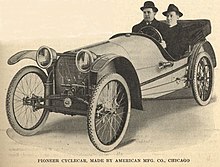Pioneer (car brand, 1914)
Pioneer was an American automobile brand in 1914. The manufacturer was the American Manufacturing Company of Chicago (Illinois) .
The Pioneer brand
The Pioneer was the last of a total of nine automobile projects of this name in the USA between 1896 and 1914 - and one of only four that actually resulted in at least one road vehicle. Only the Pioneer Car Company in Oklahoma had previously produced notable numbers with a highwheeler . However, there is no known relationship between the American Manufacturing Company and other manufacturers of a Pioneer automobile.
Company history
This company was a subsidiary of from the first in June 1913 merger of the Chicago Automobile Trade house with the Palmer Motor Car Company incurred Partin Manufacturing Company , based in Rochelle and Chicago. Their brand names were Partin and Partin-Palmer . The Pioneer should complement the offer downwards. American Manufacturing acted independently and made a secret of the owners for a long time. The fact that these were specialists from the automotive industry was so unusual in this market segment with numerous small and very small manufacturers that speculation arose about it in the press. Cyclecars experienced a huge boom between 1912 and 1915, but it cooled off just as quickly as it had emerged. Unfortunately, he also encouraged hobbyists and tinkerers with less serious designs to try their hand at being a manufacturer; this already carried one of the seeds of the sudden decline of this type of vehicle.
The American Manufacturing Company is different . Your Pioneer Staggered Roadster came onto the market as a fairly conventional representative of its class, but is considered a successful design. The name refers to the two staggered seats next to each other. Many cyclecars had a tandem seat arrangement because of the narrow body, in some models such as the French Bédélia the passenger sat in front. The sales price was a reasonable US $ 385.00.
When the parent company ran into financial difficulties at the end of 1914, an investor was found in the person of sales director Charles C. Darnall who took it over. He reorganized it as the Commonwealth Motors Corporation . However, the American Manufacturing Company was given up, which is why the Pioneer had already disappeared from the market at the end of the first year of production.
The Commonwealth Motors Corporation is one of two companies from the 1922 Checker Cab Manufacturing Company was born. Hence, the Pioneer is something of a distant relative of the famous Checker Cab .
technology
The Pioneer was referred to as a cycle car, although it did not meet the criteria. It was a typical representative of its genre, made of lightweight construction with an air-cooled V2 engine, friction gear , belt drive and a narrower track than ordinary cars. Its roadster body was so narrow that the front passenger seat had to be moved back around 30 cm and placed a little lower, especially to give the driver more elbow room in the 1016 mm wide car.
An air-cooled V2 engine with 9 bhp (6.6 kW) power and a displacement of 69.3 ci (1136 cm³) drove the Pioneer. The capacity limit for cycle cars was 1100 cc. The bore was 3⅜ inches (85.725 mm) and the stroke was 3⅞ inches (98.425 mm). At that time, the drilling resulted in the tax class (the so-called NACC rating), the Pioneer with 9.1 HP. was calculated.
The power was transmitted to the rear wheels via a friction roller drive and flat belts .
model
Pioneer only built a single model in a single version:
| model |
Vehicle and tax class |
Construction period | cylinder | Displacement | power | wheelbase | Superstructures |
|---|---|---|---|---|---|---|---|
| Pioneer 9 HP Staggered Roadster |
Cyclecar, 9.1 HP | 1914 | 2 V | 1136 cc | 9 bhp (6.6 kW) | 2438 mm | Roadster 2 seats |
Remarks
- ↑ Predecessor formula for SAE-PS . The NACC ( National Automobile Chamber of Commerce ) was an association of the automobile industry founded in 1913 and the successor to the ALAM ( Association of Licensed Automobile Manufacturers ), which introduced the first standards in US automobile manufacturing in 1903. The benefit is calculated; Cylinder bore ² × number of cylinders; the result is divided by 2.5. SAE-PS was later developed from this formula , it is also the basis of the British tax-PS at that time.
literature
- Kimes, Beverly Ray & Clark Jr., Henry Austin: Standard Catalog of American Cars 1805-1942 , Krause Publications, Iola WI (1985), ISBN 0-87341-045-9
- Dluhy, Robert D .: American Automobiles of the Brass Era: Essential Specifications of 4,000+ Gasoline Powered Passenger Cars, 1906-1915, with a Statistical and Historical Overview. McFarland & Co Inc. Publishers, Jefferson NC, 2013; ISBN 0-78647-136-0 .
- National Automobile Chamber of Commerce (Ed.): Handbook of Automobiles 1915–1916. Dover Publications, 1970.
Web links
Individual evidence
- ↑ a b Kimes, Clark: Standard Catalog of American Cars 1805-1942. 1996, pp. 1194-1195 (div. Pioneer).
- ↑ a b c d e Kimes, Clark: Standard Catalog of American Cars 1805-1942. 1996, p. 1195 (Pioneer).
- ↑ a b Dluhy: American Automobiles of the Brass Era. 2013, p. 108 (Pioneer)
- ^ Kimes, Clark: Standard Catalog of American Cars 1805-1942. 1996, pp. 1153-1154 (Palmer, Partin-Palmer).
- ↑ a b N.ACC: Handbook of Automobiles 1915–1916 , p. 212 (HP Rating)
